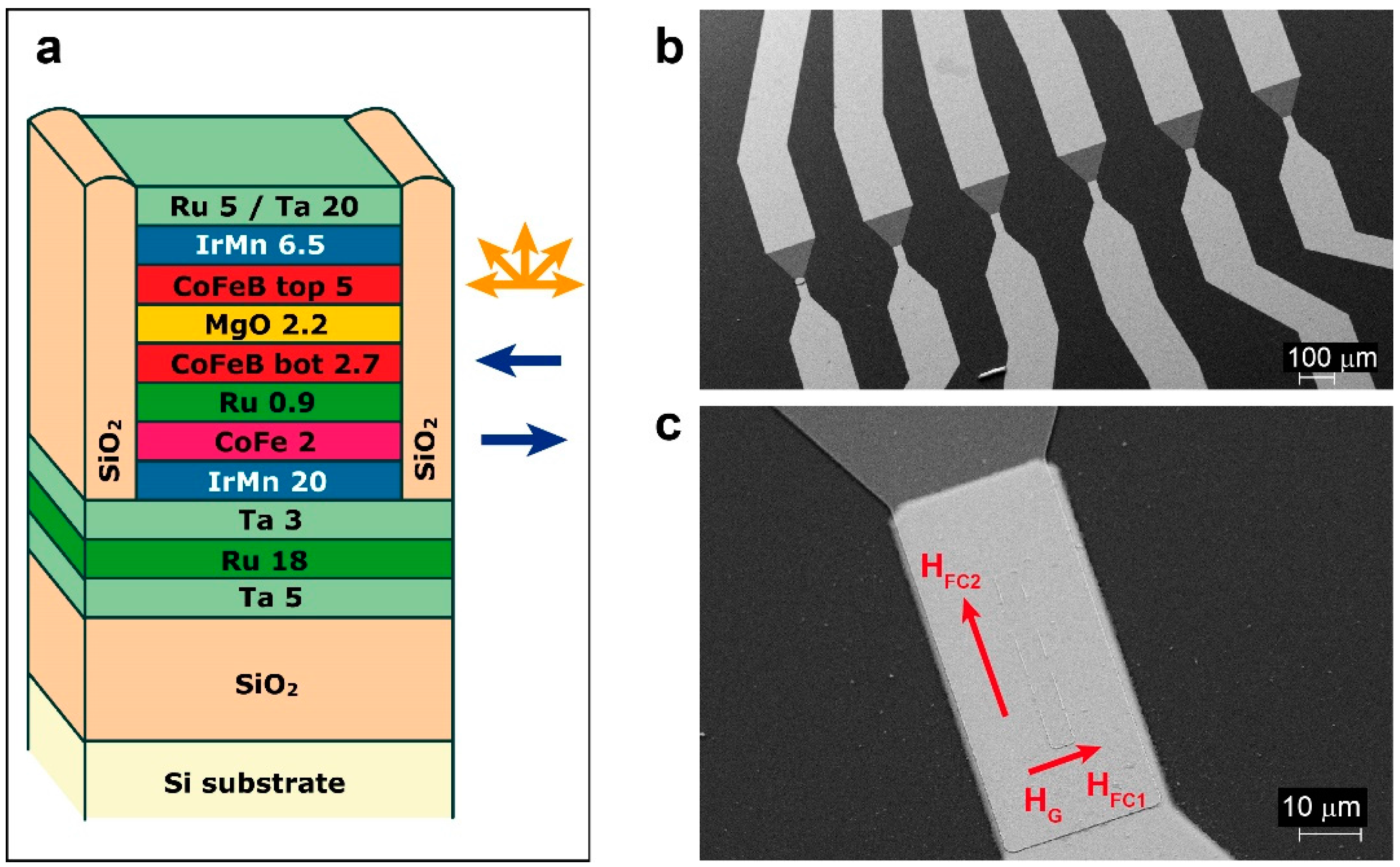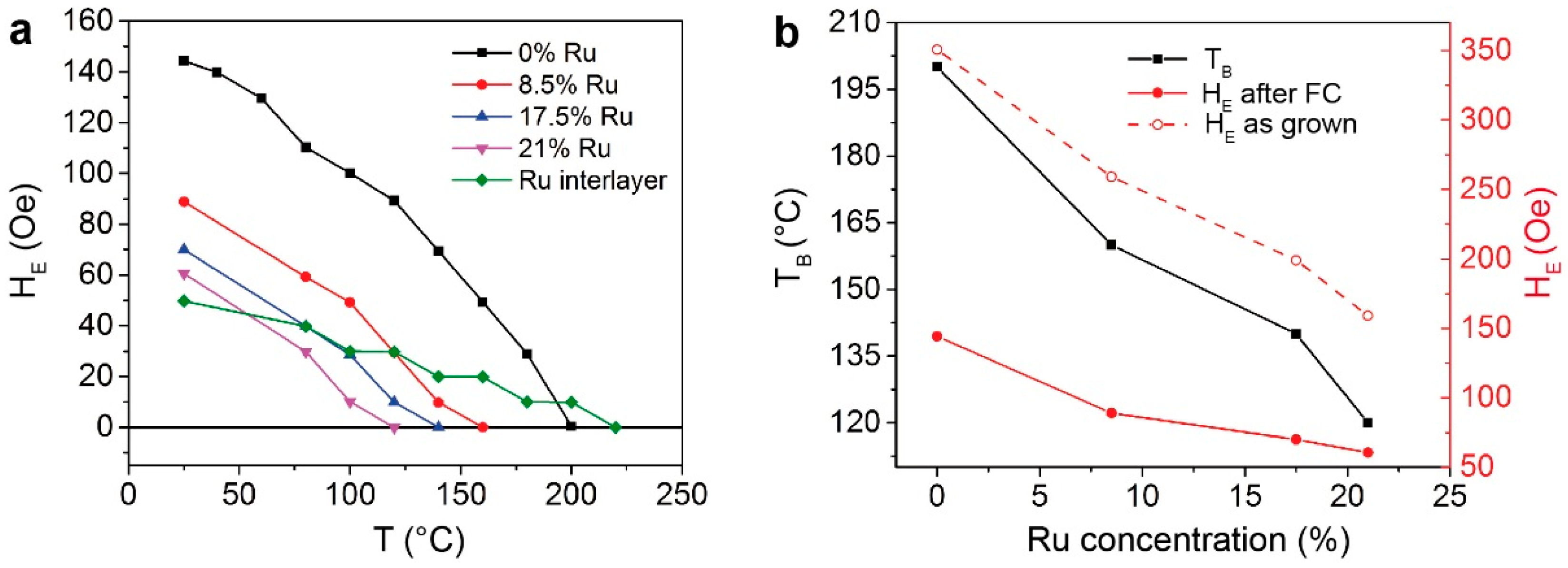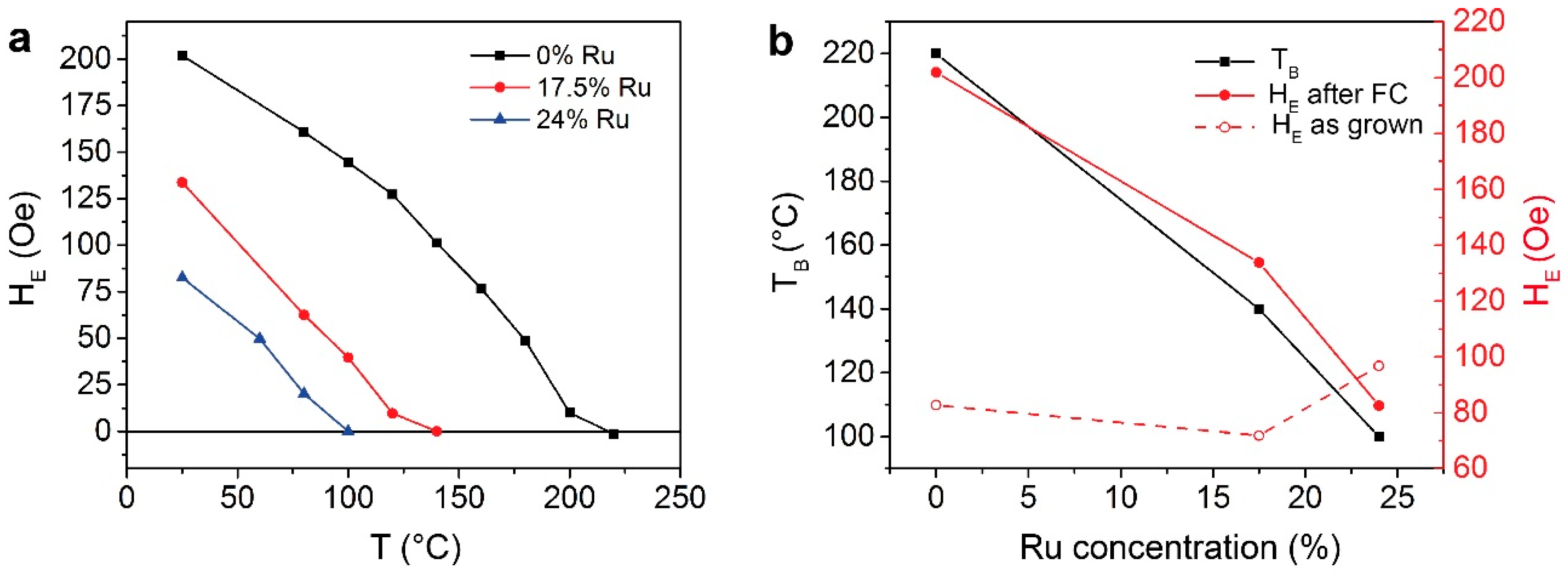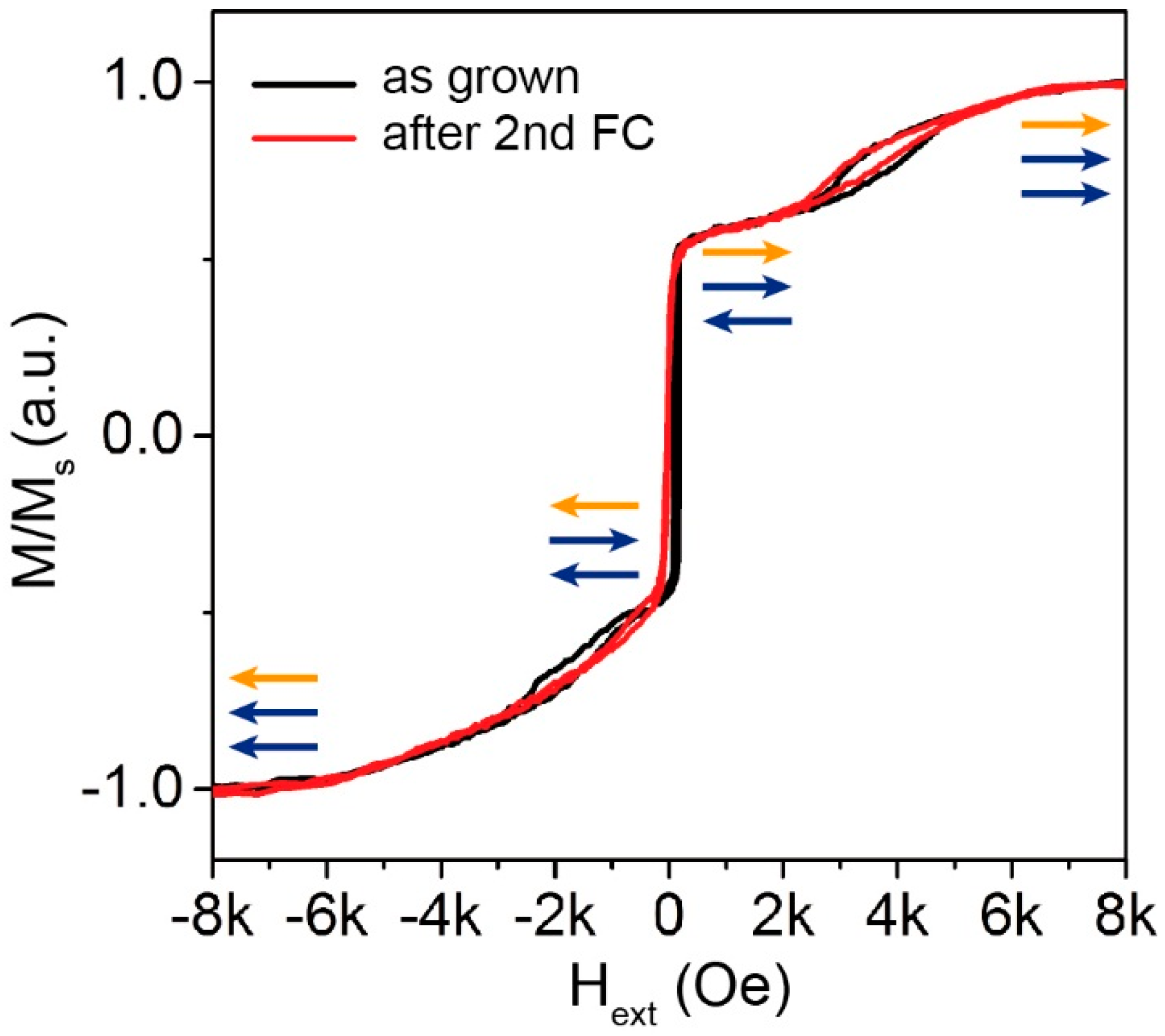Exchange Bias Tuning for Magnetoresistive Sensors by Inclusion of Non-Magnetic Impurities
Abstract
:1. Introduction
2. Materials and Methods
2.1. Sample Fabrication
- Sample A0 0% Ru: Co40Fe40B20(5 nm)/Ir22Mn78(6.5 nm)/Ru(2 nm)
- Sample A1 8.5% Ru: Co40Fe40B20(5 nm)/[Ir22Mn78(0.5 nm)/Ru(0.05 nm)]12/Ir22Mn78(0.5 nm)/Ru(2 nm)
- Sample A2 17.5% Ru: Co40Fe40B20(5 nm)/[Ir22Mn78(0.5 nm)/Ru(0.09 nm)]12/Ir22Mn78(0.5 nm)/Ru(2 nm)
- Sample A3 21% Ru: Co40Fe40B20(5 nm)/[Ir22Mn78(0.5 nm)/Ru(0.11 nm)]12/Ir22Mn78(0.5 nm)/Ru(2 nm)
- Sample A5 Ru interlayer: Co40Fe40B20(5 nm)/Ru(0.2 nm)/Ir22Mn78(6.5 nm)/Ru(2 nm)
- Sample B0 0% Ru: Ir22Mn78(6.5 nm)/Co40Fe40B20 (5 nm)/Ru(2 nm)
- Sample B2 17.5% Ru: [Ir22Mn78(0.5 nm)/Ru(0.09 nm)]12/Ir22Mn78(0.5 nm)/Co40Fe40B20(5 nm)/Ru(2 nm)
- Sample B4 25% Ru: [Ir22Mn78(0.5 nm)/Ru(0.14 nm)]12/Ir22Mn78(0.5 nm)/Co40Fe40B20(5 nm)/Ru(2 nm)
2.2. Sample Characterization
3. Results
3.1. Blocking Temperature and Exchange Bias Field in Top- and Bottom-Pinned Samples
3.2. Magnetic Tunneling Junction with Two Pinned Electrodes
4. Discussion
5. Conclusions
Acknowledgments
Author Contributions
Conflicts of Interest
Abbreviations
| SV | Spin Valve |
| MTJ | Magnetic Tunneling Junctions |
| SAF | Synthetic AntiFerromagnet |
| PMA | Perpendicular Magnetic Anisotropy |
| AFM | Antiferromagnet |
| TMR | Tunneling MagnetoResistance |
| SEM | Scanning Electron Microscope |
| VSM | Vibrating Sample Magnetometer |
| DC | Direct Current |
| FM | Ferromagnet |
| MR | MagnetoResistance |
References
- Sanz, R.; Fernández, A.B.; Dominguez, J.A.; Martín, B.; Michelena, M.D. Gamma irradiation of magnetoresistive sensors for planetary exploration. Sensors 2012, 12, 4447–4465. [Google Scholar] [CrossRef] [PubMed]
- Reig, C.; Cubells-Beltran, M.-D.; Muñoz, D.R. Magnetic Field Sensors Based on Giant Magnetoresistance (GMR) Technology: Applications in Electrical Current Sensing. Sensors 2009, 9, 7919–7942. [Google Scholar] [CrossRef] [PubMed]
- Byun, Y.S.; Jeong, R.G.; Kang, S.W. Vehicle position estimation based on magnetic markers: Enhanced accuracy by compensation of time delays. Sensors 2015, 15, 28807–28825. [Google Scholar] [CrossRef] [PubMed]
- Treutler, C.P. Magnetic sensors for automotive applications. Sens. Actuators A Phys. 2001, 91, 2–6. [Google Scholar] [CrossRef]
- Graham, D.L.; Ferreira, H.A.; Freitas, P.P. Magnetoresistive-based biosensors and biochips. Trends Biotechnol. 2004, 22, 455–462. [Google Scholar] [CrossRef] [PubMed]
- Albisetti, E.; Petti, D.; Damin, F.; Cretich, M.; Torti, A.; Chiari, M.; Bertacco, R. Photolithographic bio-patterning of magnetic sensors for biomolecular recognition. Sens. Actuators B Chem. 2014, 200, 39–46. [Google Scholar] [CrossRef]
- Martins, V.C.; Cardoso, F.A.; Germano, J.; Cardoso, S.; Sousa, L.; Piedade, M.; Freitas, P.P.; Fonseca, L.P. Femtomolar limit of detection with a magnetoresistive biochip. Biosens. Bioelectron. 2009, 24, 2690–2695. [Google Scholar] [CrossRef] [PubMed]
- Shen, W.; Schrag, B.D.; Carter, M.J.; Xiao, G. Quantitative detection of DNA labeled with magnetic nanoparticles using arrays of MgO-based magnetic tunnel junction sensors. Appl. Phys. Lett. 2008, 93. [Google Scholar] [CrossRef]
- Gaster, R.S.; Xu, L.; Han, S.-J.; Wilson, R.J.; Hall, D.A.; Osterfeld, S.J.; Yu, H.; Wang, S.X. Quantification of protein interactions and solution transport using high-density GMR sensor arrays. Nat. Nanotechnol. 2011, 6, 314–320. [Google Scholar] [CrossRef] [PubMed]
- Albisetti, E.; Petti, D.; Damin, F.; Cretich, M.; Bagnati, M.; Sola, L.; Chiari, M.; Bertacco, R. Optimization of the bio-functionalized area of magnetic biosensors. Eur. Phys. J. B 2013, 86. [Google Scholar] [CrossRef]
- Pannetier, M.; Fermon, C.; Le Goff, G.; Simola, J.; Kerr, E. Femtotesla magnetic field measurement with magnetoresistive sensors. Science 2004, 304, 1648–1650. [Google Scholar] [CrossRef] [PubMed]
- Amaral, J.; Pinto, V.; Costa, T.; Gaspar, J.; Ferreira, R.; Paz, E.; Cardoso, S.; Freitas, P.P. Integration of TMR sensors in silicon microneedles for magnetic measurements of neurons. IEEE Trans. Magn. 2013, 49, 3512–3515. [Google Scholar] [CrossRef]
- Amaral, J.; Cardoso, S.; Freitas, P.P.; Sebastião, A.M. Toward a system to measure action potential on mice brain slices with local magnetoresistive probes. J. Appl. Phys. 2011, 109. [Google Scholar] [CrossRef]
- Beach, R.S.; McCord, J.; Webb, P.; Mauri, D. Orthogonal pinning of two ferromagnetic layers in a synthetic spin valve. Appl. Phys. Lett. 2002, 80. [Google Scholar] [CrossRef]
- Wiśniowski, P.; Almeida, J.M.; Cardoso, S.; Barradas, N.P.; Freitas, P.P. Effect of free layer thickness and shape anisotropy on the transfer curves of MgO magnetic tunnel junctions. J. Appl. Phys. 2008, 103. [Google Scholar] [CrossRef]
- Chaves, R.C.; Freitas, P.P.; Ocker, B.; Maass, W. MgO based picotesla field sensors. J. Appl. Phys. 2008, 103, 2014–2017. [Google Scholar] [CrossRef]
- Leitao, D.; Coelho, P.; Borme, J.; Knudde, S.; Cardoso, S.; Freitas, P. Ultra-Compact 100 × 100 μm2 Footprint Hybrid Device with Spin-Valve Nanosensors. Sensors 2015, 15, 30311–30318. [Google Scholar] [CrossRef] [PubMed]
- Liu, X.; Ren, C.; Xiao, G. Magnetic tunnel junction field sensors with hard-axis bias field. J. Appl. Phys. 2002, 92. [Google Scholar] [CrossRef]
- Zeng, Z.M.; Khalili Amiri, P.; Katine, J.A.; Langer, J.; Wang, K.L.; Jiang, H.W. Nanoscale magnetic tunnel junction sensors with perpendicular anisotropy sensing layer. Appl. Phys. Lett. 2012, 101. [Google Scholar] [CrossRef]
- Teixeira, J.M.; Ventura, J.; Fernández-García, M.P.; Araujo, J.P.; Sousa, J.B.; Wisniowski, P.; Leitao, D.C.; Freitas, P.P. Exchange biased CoFeB-MgO tunnel junctions at the onset of perpendicular anisotropy with in-plane/out-of-plane sensing capabilities. J. Appl. Phys. 2012, 111. [Google Scholar] [CrossRef]
- Almeida, J.M.; Wisniowski, P.; Freitas, P.P. Field detection in single and double barrier MgO magnetic tunnel junction sensors. J. Appl. Phys. 2008, 103, 2006–2009. [Google Scholar] [CrossRef]
- Chen, J.Y.; Feng, J.F.; Coey, J.M.D. Tunable linear magnetoresistance in MgO magnetic tunnel junction sensors using two pinned CoFeB electrodes. Appl. Phys. Lett. 2012, 100. [Google Scholar] [CrossRef]
- Negulescu, B.; Lacour, D.; Montaigne, F.; Gerken, A.; Paul, J.; Spetter, V.; Marien, J.; Duret, C.; Hehn, M. Wide range and tunable linear magnetic tunnel junction sensor using two exchange pinned electrodes. Appl. Phys. Lett. 2009, 95. [Google Scholar] [CrossRef]
- Ferreira, R.; Paz, E.; Freitas, P.P.; Wang, J.; Xue, S. Large area and low aspect ratio linear magnetic tunnel junctions with a soft-pinned sensing layer. IEEE Trans. Magn. 2012, 48, 3719–3722. [Google Scholar] [CrossRef]
- Nogués, J.; Schuller, I.K. Exchange bias. J. Magn. Magn. Mater. 1999, 192, 203–232. [Google Scholar] [CrossRef]
- Devasahayam, A.J.; Kryder, M.H. The dependence of the antiferromagnet/ferromagnet blocking temperature on antiferromagnet thickness and deposition conditions. J. Appl. Phys. 1999, 85, 5519–5521. [Google Scholar] [CrossRef]
- O’Grady, K.; Fernandez-Outon, L.E.; Vallejo-Fernandez, G. A new paradigm for exchange bias in polycrystalline thin films. J. Magn. Magn. Mater. 2010, 322, 883–899. [Google Scholar] [CrossRef]
- Lee, S.S.; Choi, J.G.; Kim, S.W.; Rhee, J.R.; Hwang, D.G. Antiferromagnet IrMn thickness dependence in exchange-biased perpendicular magnetic anisotropy based on CoFe/Pt/CoFe/[IrMn(tIrMn)] multilayers. J. Magn. Magn. Mater. 2006, 304, e91–e93. [Google Scholar] [CrossRef]
- Prejbeanu, I.L.; Kerekes, M.; Sousa, R.C.; Sibuet, H.; Redon, O.; Dieny, B.; Nozières, J.P. Thermally assisted MRAM. J. Phys. Condens. Matter 2007, 19. [Google Scholar] [CrossRef]
- Albisetti, E.; Petti, D.; Pancaldi, M.; Madami, M.; Tacchi, S.; Curtis, J.; King, W.P.; Papp, A.; Csaba, G.; Porod, W.; et al. Nanopatterning reconfigurable magnetic landscapes via thermally assisted scanning probe lithography. Nat. Nanotechnol. 2016, 11, 545–551. [Google Scholar] [CrossRef] [PubMed]
- Albisetti, E.; Petti, D. Domain wall engineering through exchange bias. J. Magn. Magn. Mater. 2016, 400, 230–235. [Google Scholar] [CrossRef]
- Donolato, M.; Vavassori, P.; Gobbi, M.; Deryabina, M.; Hansen, M.F.; Metlushko, V.; Ilic, B.; Cantoni, M.; Petti, D.; Brivio, S.; et al. On-chip manipulation of protein-coated magnetic beads via domain-wall conduits. Adv. Mater. 2010, 22, 2706–2710. [Google Scholar] [CrossRef] [PubMed]
- Allwood, D.A.A.; Xiong, G.; Faulkner, C.C.; Atkinson, D.; Petit, D.; Cowburn, R.P. Magnetic domain-wall logic. Science 2005, 309, 1688–1692. [Google Scholar] [CrossRef] [PubMed]
- Yuasa, S.; Suzuki, Y.; Katayama, T.; Ando, K. Characterization of growth and crystallization processes in CoFeB/MgO/CoFeB magnetic tunnel junction structure by reflective high-energy electron diffraction. Appl. Phys. Lett. 2005, 87. [Google Scholar] [CrossRef]
- Malinowski, G.; Hehn, M.; Robert, S.; Lenoble, O.; Schuhl, A. Correlation between structural quality and magnetic properties of IrMn-based multilayers. J. Appl. Phys. 2005, 98. [Google Scholar] [CrossRef]
- Albisetti, E.; Petti, D.; Cantoni, M.; Damin, F.; Torti, A.; Chiari, M.; Bertacco, R. Conditions for efficient on-chip magnetic bead detection via magnetoresistive sensors. Biosens. Bioelectron. 2013, 47, 213–217. [Google Scholar] [CrossRef] [PubMed]
- Petti, D. Magnetic Tunneling Junctions for biosensors: Form the growth to the detection. Nuovo Cim. C 2012, 35, 149–156. [Google Scholar]
- Donolato, M.; Sogne, E.; Dalslet, B.T.; Cantoni, M.; Petti, D.; Cao, J.; Cardoso, F.; Cardoso, S.; Freitas, P.P.; Hansen, M.F.; et al. On-chip measurement of the Brownian relaxation frequency of magnetic beads using magnetic tunneling junctions. Appl. Phys. Lett. 2011, 98. [Google Scholar] [CrossRef]
- Fulara, H.; Chaudhary, S.; Kashyap, S.C.; Pandya, D.K. Positive exchange bias in as-deposited ion-beam sputtered IrMnCoFeB system. J. Appl. Phys. 2011, 110, 20–24. [Google Scholar] [CrossRef]
- Kerr, E.; van Dijken, S.; Coey, J.M.D. Influence of the annealing field strength on exchange bias and magnetoresistance of spin valves with IrMn. J. Appl. Phys. 2005, 97. [Google Scholar] [CrossRef]
- You, C.Y.; Goripati, H.S.; Furubayashi, T.; Takahashi, Y.K.; Hono, K. Exchange bias of spin valve structure with a top-pinned Co40Fe40B20/IrMn. Appl. Phys. Lett. 2008, 93, 012501. [Google Scholar] [CrossRef]
- Fernandez-Outon, L.E.; Araújo Filho, M.S.; Araújo, R.E.; Ardisson, J.D.; Macedo, W.A.A. Setting temperature effect in polycrystalline exchange-biased IrMn/CoFe bilayers. J. Appl. Phys. 2013, 113. [Google Scholar] [CrossRef]
- Anderson, G.; Huai, Y.; Miloslawsky, L. CoFe/IrMn exchange biased top, bottom, and dual spin valves. J. Appl. Phys. 2000, 87. [Google Scholar] [CrossRef]
- Zhu, J.G. Spin valve and dual spin valve heads with synthetic antiferromagnets. IEEE Trans. Magn. 1999, 35, 655–660. [Google Scholar]





| Material | Pressure (mTorr) | Power on 2 Inches Target (W) |
|---|---|---|
| Ta | 3 | 100 DC |
| Ru | 3 | 50 DC |
| Co40Fe40B20 | 3 | 58 DC |
| Ir22Mn78 | 3 | 50 DC |
| MgO | 2 | 220 RF |
| Co60Fe40 | 12 | 200 RF |
© 2016 by the authors; licensee MDPI, Basel, Switzerland. This article is an open access article distributed under the terms and conditions of the Creative Commons Attribution (CC-BY) license (http://creativecommons.org/licenses/by/4.0/).
Share and Cite
Sharma, P.P.; Albisetti, E.; Monticelli, M.; Bertacco, R.; Petti, D. Exchange Bias Tuning for Magnetoresistive Sensors by Inclusion of Non-Magnetic Impurities. Sensors 2016, 16, 1030. https://doi.org/10.3390/s16071030
Sharma PP, Albisetti E, Monticelli M, Bertacco R, Petti D. Exchange Bias Tuning for Magnetoresistive Sensors by Inclusion of Non-Magnetic Impurities. Sensors. 2016; 16(7):1030. https://doi.org/10.3390/s16071030
Chicago/Turabian StyleSharma, Parikshit Pratim, Edoardo Albisetti, Marco Monticelli, Riccardo Bertacco, and Daniela Petti. 2016. "Exchange Bias Tuning for Magnetoresistive Sensors by Inclusion of Non-Magnetic Impurities" Sensors 16, no. 7: 1030. https://doi.org/10.3390/s16071030
APA StyleSharma, P. P., Albisetti, E., Monticelli, M., Bertacco, R., & Petti, D. (2016). Exchange Bias Tuning for Magnetoresistive Sensors by Inclusion of Non-Magnetic Impurities. Sensors, 16(7), 1030. https://doi.org/10.3390/s16071030








